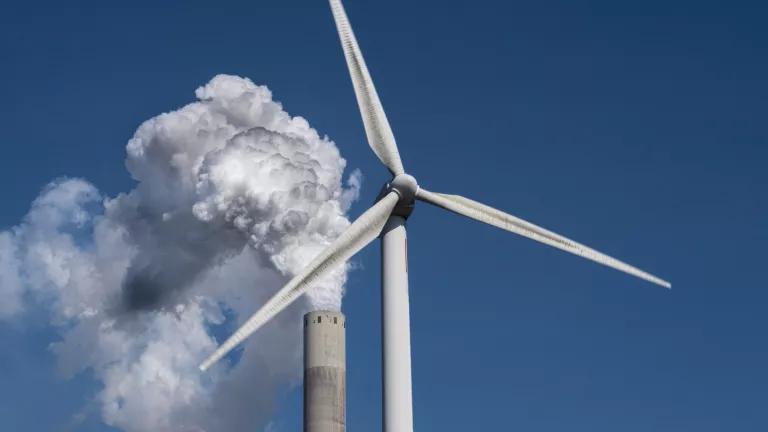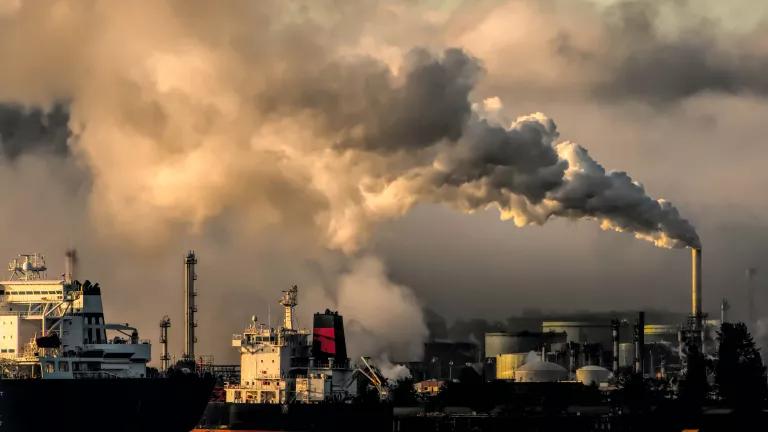Towards A Cleaner, Better Power Sector
After the hottest year on record, curbing power plant carbon pollution is more urgent than ever. Fortunately, we can get there from here.

iStock
This blog is part of NRDC’s year-end series reviewing 2023 climate and clean energy developments.
This year was the hottest year on record, underscoring the urgency of shifting to clean energy and curbing the carbon pollution that is driving the climate crisis. Power plants are one of the largest sources of carbon emissions, and also the sector with the lowest cost opportunities to cut climate pollution. We need to replace dirty fossil fuels with clean electricity in order to address the climate crisis.
It’s now clearer than ever that we can get there from here. We have seen this year the continuation of the power sector’s shift towards clean energy and the start of new federal and state policies to accelerate that shift.
The Carbon Layer Cake

NRDC
Think of the power sector’s transformation as a layer cake. The bottom layer represents underlying market forces that for the last decade have been moving the power sector away from old, dirty fossil fuels like coal and toward cleaner options like wind, solar, and batteries. Those trends continued in 2023. Coal’s market share continued to fall, dropping 3 percent from 2022 to 2023 and 6 percent since 2021. Coal makes up just 17 percent of power generation now, down from 45 percent of generation in 2010.
NRDC’s annual benchmark report showed that power sector carbon dioxide emissions are down 34 percent from the sector’s 2007 peak. Other health-harming power sector pollutants have also fallen sharply, reducing the sector’s contribution to soot, smog, and ground-level ozone that contribute to respiratory illnesses, exacerbate childhood asthma, and even lead to premature death. In large part because of strong standards put in place by the Environmental Protection Agency since 2000, mercury air emissions have decreased —93 percent since 2000. Over the same period, sulfur dioxide emissions have dropped by 92 percent and nitrogen oxide emissions by 84 percent.
Meanwhile, renewables had historic growth in 2023, continuing recent trends. Wind, solar, and storage combined are estimated to make up 82 percent of new electric capacity additions this year, with solar accounting for more than half of that. In fact, the latest data shows solar is on track for a record-setting year – double last year’s total. Battery storage capacity is set to double, too. Compare that to meager growth for natural gas power, which make up less than 16 percent of capacity additions this year.
Market trends are moving the power sector toward a future that relies more on renewable energy and less on fossil fuels. Renewable energy is projected to account for 22 percent of the market generation share in 2023, more than coal and nuclear for the second year in a row. Carbon emissions keep falling as a result.
The second layer of the cake represents the huge boost to the clean energy transition from the power sector provisions of the 2022 Inflation Reduction Act, as well as the Bipartisan Infrastructure Law enacted the year before. These laws provide very attractive tax incentives and grants to accelerate the pace of the power sector’s transition to cleaner energy.
As a result of the historic support from the IRA, renewable energy is poised to surge in the coming years leading to a decline in carbon emissions from the sector of as much as 87 percent by 2035 from 2005, according to a comprehensive modeling analysis done by NRDC and other private and government researchers. Wind and solar capacity could grow to six times the current level by 2035.
Though there has been progress, there is still work to be done and a historic opportunity is within reach. The IRA is projected to cut emissions economy-wide between 33 and 40 percent (37 percent average across the literature) by 2030, about halving the gap to the U.S. commitment to cut GHG pollution by 50 percent by 2030 (from 2005 levels). Up to 80 percent of these IRA-driven emission reductions will come from the power sector.
Then there’s the icing on the cake. In May, EPA proposed carbon pollution standards for existing coal power plants and for new and existing gas plants. These standards, which EPA plans to finalize in April 2024, respond to EPA’s legal obligation under the Clean Air Act to set limits on power plants’ dangerous carbon pollution. They have been crafted in accordance with the Supreme Court’s 2022 decision in West Virginia v. EPA, which told the agency not only what it cannot do, but what it can do under the nation’s foundational clean air law: set standards based on technologies that “cause existing power plants to operate more cleanly.” The EPA standards will work hand-in-glove with the IRA’s incentives, adding modestly to the projected reductions and serving as a backstop to ensure the IRA’s success. NRDC and its partners have shown how the EPA proposal can be strengthened to deliver more reductions, at lower overall cost.
We Can Have the Cake and Eat It Too
The new power sector we are heading towards will generate many more clean energy jobs, according to a report by NRDC’s sister organization, Environmental Entrepreneurs. The report projects 74,000 clean energy jobs will be created just by new clean energy and clean vehicle projects announced this year. Over the past two years, clean energy job growth is more than 10 percent, the fastest rate in the energy sector.
To realize the low-carbon power sector of the future and this clean energy job growth, it is crucial that EPA finalize strong carbon pollution standards, this April. This year showed us that the wind is blowing in the right direction, pushing us toward a cleaner power system and a better future. But we need a steady hand on the tiller from EPA in 2024 to ensure we stay on course.





